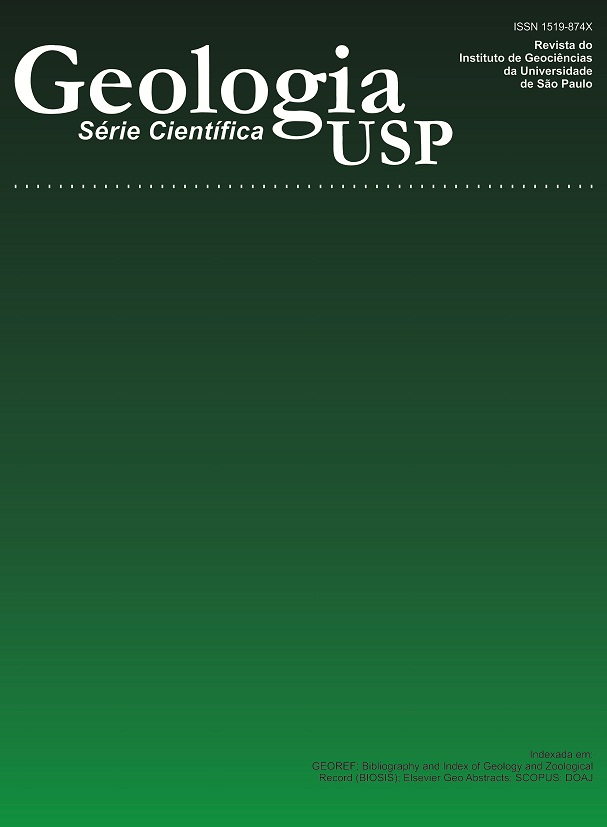Reconstituição paleoambiental das formações Motuca e Sambaíba, Permo-Triássico da Bacia do Parnaíba no sudoeste do Estado do Maranhão, Brasil
DOI:
https://doi.org/10.5327/Z1519-874X201300030007Resumo
O intervalo que compreende o final do Paleozoico e início do Mesozoico foi marcado por mudanças globais paleogeográficas e paleoclimáticas, em parte atribuídas a eventos catastróficos. A intensa continentalização do supercontinente Pangeia, com a implantação de extensos desertos, sucedeu os ambientes costeiro-plataformais do início do Permiano. Os registros desses eventos no norte do Brasil são encontrados nas bacias intracratônicas, particularmente na sucessão Permotriássica da Bacia do Parnaíba. A análise de fácies e estratigráfica de afloramentos desta sucessão permitiu a individualização de 14 fácies sedimentares agrupadas em 4 associações de fácies (AF): AF1 e AF2, relacionadas aos depósitos da Formação Motuca, e AF3 e AF4, representativas da base da Formação Sambaíba. A AF1 - Lacustre raso/Mudflat consiste em pelitos vermelhos laminados com lentes de gipsita, calcita e marga, além de lobos de arenitos sigmoidais. A AF2 - Saline pan é constituída por corpos lenticulares de gipso laminado, gipso nodular e gipsarenito, sobrepostos por pelitos esverdeados com nódulos de dolomita e palygorskita. A AF3 - Lençol de areia e AF4 - Campo de dunas são formadas, respectivamente, por arenitos de coloração creme alaranjada com estratificação plano-paralela e estratificação cruzada de médio a grande porte. Destaca-se o registro de intervalos deformados lateralmente contínuos por centenas de quilômetros na zona de contato entre as formações Motuca e Sambaíba. Nestes, ocorrem pelitos com camadas contorcidas e brechadas (Formação Motuca) e arenitos com falhas/microfalhas sinsedimentares, laminação convoluta e diques de injeção preenchidos por argilitos (Formação Sambaíba), interpretados como sismitos induzidos por terremotos de alta magnitude (>; 8 na escala Richter).Downloads
Os dados de download ainda não estão disponíveis.
Publicado
2013-09-01
Edição
Seção
Artigos
Licença
Autores que publicam nesta revista concordam com os seguintes termos:
- Autores mantém os direitos autorais e concedem à revista Geologia USP. Série Científica, o direito de primeira publicação, com o trabalho sob a licença Creative Commons BY-NC-SA (resumo da Licença: https://creativecommons.org/licenses/by-nc-sa/4.0 | texto completo da licença: https://creativecommons.org/licenses/by-nc-sa/4.0/legalcode) que permite o compartilhamento do trabalho de forma não comercial e conferindo os devidos créditos autorais da primeira publicação nesta revista.
- Autores têm autorização para assumir contratos adicionais separadamente, para distribuição não-exclusiva da versão do trabalho publicada nesta revista (publicar em repositório institucional ou como capítulo de livro), conferindo os devidos créditos autorais da primeira publicação nesta revista.
- Autores têm permissão e são estimulados a publicar e distribuir seu trabalho online (em repositórios institucionais ou na sua página pessoal) a qualquer ponto antes ou durante o processo editorial, uma vez que isso pode gerar alterações produtivas, bem como aumentar o impacto e a citação do trabalho publicado (Veja O efeito do Acesso Aberto e downloads no impacto das citações).
Como Citar
Abrantes Júnior, F. R., & Nogueira, A. C. R. (2013). Reconstituição paleoambiental das formações Motuca e Sambaíba, Permo-Triássico da Bacia do Parnaíba no sudoeste do Estado do Maranhão, Brasil . Geologia USP. Série Científica, 13(3), 65-82. https://doi.org/10.5327/Z1519-874X201300030007















